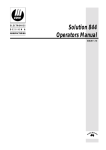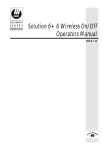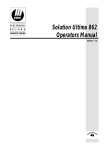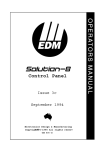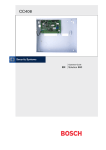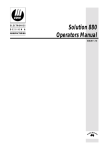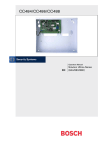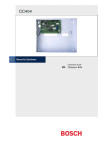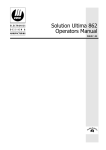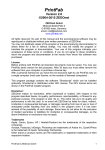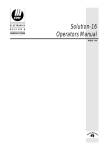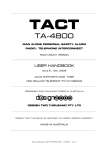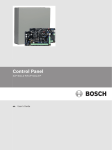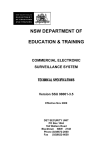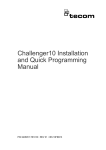Download Solution 4+4 Operators Manual
Transcript
Solution 4+4 Operators Manual ISSUE 1.25 Technical Manuals Online! - http://www.tech-man.com Technical Manuals Online! - http://www.tech-man.com Solution 4+4 Operators Manual Copyright 1997 by Electronics Design and Manufacturing Pty Limited, SYDNEY, AUSTRALIA Document Part Number MA400O Document ISSUE 1.25 Printed 01 December 1997 This documentation is provided to suit Solution 4+4 (CC400) Firmware Revision 1.20 – 1.27 Hardware Revision A Copyright Notice All rights reserved. No part of this publication may be reproduced, transmitted or stored in a retrieval system in any form or by any means, electronic, mechanical, photocopying, recording, or otherwise, without the prior written permission of Electronics Design and Manufacturing Pty Limited. Trademarks Throughout this document trademark names may have been used. Rather than put a trademark symbol in every occurrence of a trademark name, we state that we are using the names only in an editorial fashion and to the benefit of the trademark owner with no intention of infringement of the trademark. Notice of Liability While every precaution has been taken in the preparation of this document, neither Electronics Design and Manufacturing Pty Limited nor any of its official representatives shall have any liability to any person or entity with respect to any liability, loss or damage caused or alleged to be caused directly or indirectly by the information contained in this book. Electronics Design and Manufacturing Pty Limited reserves the right to make changes to features and specifications at any time without prior notification in the interest of ongoing product development and improvement. Technical Manuals Online! - http://www.tech-man.com Technical Manuals Online! - http://www.tech-man.com Table Of Contents Introduction ........................................................................................................................................7 Features ..............................................................................................................................................8 Basic System Operation ......................................................................................................................9 Code Retries ...................................................................................................................................... 10 Codepad Lockout Time ............................................................................................................................ 10 Codepad Extinguish Mode................................................................................................................ 10 Alarm Memory.................................................................................................................................. 11 Sensor Watch Time........................................................................................................................... 11 Day Alarm......................................................................................................................................... 12 Day Alarm Resetting................................................................................................................................. 12 Day Alarm Latching ................................................................................................................................. 12 Operation............................................................................................................................................................... 12 Entry Time ........................................................................................................................................ 13 Exit Time .......................................................................................................................................... 13 System Date and Time....................................................................................................................... 13 User Codes ................................................................................................................................................ 14 User Code Priority ................................................................................................................................................. 15 System Indicators and Operations .................................................................................................... 17 CP5 Eight Zone Codepad ......................................................................................................................... 17 Zone Indicators...................................................................................................................................................... 17 AWAY Indicator ................................................................................................................................................... 17 STAY Indicator ..................................................................................................................................................... 17 MAINS Indicator................................................................................................................................................... 18 FAULT Indicator................................................................................................................................................... 18 Audible Indicators ................................................................................................................................................. 18 CP5 Eight Zone LCD Codepad ................................................................................................................ 19 Zone Indicators...................................................................................................................................................... 19 AWAY Indicator ................................................................................................................................................... 19 STAY Indicator ..................................................................................................................................................... 19 System Disarmed................................................................................................................................................... 20 MAINS Indicator................................................................................................................................................... 20 Zone Isolating Mode .............................................................................................................................................. 20 FAULT Indicator................................................................................................................................................... 20 Programming Mode ............................................................................................................................................... 20 Off Indicator/Zone Sealed ...................................................................................................................................... 21 On Indicator/Zone In Alarm................................................................................................................................... 21 Audible Indicators ................................................................................................................................................. 21 System Operations............................................................................................................................. 22 Arming The System In AWAY Mode ...................................................................................................... 22 Disarming The System From AWAY Mode............................................................................................. 23 Arming The System In STAY Mode ........................................................................................................ 23 Disarming The System From STAY Mode .............................................................................................. 25 Codepad Functions ........................................................................................................................... 26 Isolating Zones ................................................................................................................................. 27 Standard Isolating..................................................................................................................................... 27 Code To Isolate ......................................................................................................................................... 28 Technical Manuals Online! - http://www.tech-man.com Fault Analysis Mode......................................................................................................................... 29 Fault Descriptions ..................................................................................................................................... 30 Low Battery ...........................................................................................................................................................30 Date and Time........................................................................................................................................................30 Sensor Watch.........................................................................................................................................................30 Horn Speaker Monitor............................................................................................................................................30 Reserved ................................................................................................................................................................30 E2 Fault..................................................................................................................................................................30 Reserved ................................................................................................................................................................30 Communication Failure ..........................................................................................................................................30 AC Mains Failure...................................................................................................................................................30 Codepad Duress Alarm............................................................................................................................. 31 Codepad Panic Alarm - Versions Up To 1.26 .......................................................................................... 31 Codepad Panic Alarm – Version 1.27 Onwards ...................................................................................... 31 Codepad Fire Alarm – Version 1.27 Onwards......................................................................................... 31 Codepad Medical Alarm – Version 1.27 Onwards .................................................................................. 31 Master Code Functions .................................................................................................................... 32 Reserved ................................................................................................................................................................32 Changing and Deleting User Codes.........................................................................................................................33 Changing Domestic Phone Numbers.......................................................................................................................35 Event Memory Recall Mode ...................................................................................................................................37 Walk Test Mode.....................................................................................................................................................38 Fault Analysis Mode...............................................................................................................................................39 Setting The Date and Time .....................................................................................................................................40 Turning Day Alarm On and Off ..............................................................................................................................40 Reset Latching Outputs ..........................................................................................................................................41 Initiate A Modem Call............................................................................................................................................41 Hold Down Functions ............................................................................................................................... 42 Arm The System In AWAY Mode..........................................................................................................................42 Arm The System In STAY Mode............................................................................................................................42 Horn Speaker Test..................................................................................................................................................42 Bell Test ................................................................................................................................................................42 Strobe Test.............................................................................................................................................................43 Turning Day Alarm On and Off ..............................................................................................................................43 Fault Analysis Mode...............................................................................................................................................44 Initiate A Modem Call............................................................................................................................................44 Reset Latching Outputs ..........................................................................................................................................44 Codepad and Beeper Tone Change .........................................................................................................................45 Initiate A Test Report .............................................................................................................................................45 Communication Options................................................................................................................... 46 Remote Arming Via The Telephone......................................................................................................... 47 Domestic Dialling Reporting..................................................................................................................... 48 Basic Pager Reporting .............................................................................................................................. 49 Optional Equipment ......................................................................................................................... 50 Glossary Of Terms............................................................................................................................ 52 Warranty........................................................................................................................................... 55 Limitations.............................................................................................................................................................56 Maintenance...........................................................................................................................................................56 Specifications.........................................................................................................................................................57 Advice To Users.....................................................................................................................................................58 New Zealand Telepermit Notes...............................................................................................................................58 Quality Policy ........................................................................................................................................................59 Installation Notes ............................................................................................................................. 60 Service Notes .................................................................................................................................... 63 Index................................................................................................................................................. 65 Technical Manuals Online! - http://www.tech-man.com Solution 4+4 Operators Manual 7 Introduction Congratulations on selecting the Solution 4+4 control panel to protect you and your property. So that you can obtain the most from your unit, we suggest that you take the time to read through this manual and familiarise yourself with the numerous outstanding operating features of this system. You will notice that in all aspects of planning, engineering, styling, operation, convenience and adaptability, we have sought to anticipate your every possible requirement. Programming simplicity and speed have been some of the major considerations and we believe that our objectives in this area have been more than satisfied. This manual will explain all aspects of operating the control panel. All system parameters and options are detailed, however suitability is left up to the individual. Every system can be tailored to meet all requirements quickly and easily. The Solution range of control panels are very popular with thousands of people throughout many countries of the globe, all of whom have various levels of technical aptitude and ability. We have tried to aim this manual at all levels of readers. As Solution control panels continue to be improved over the years, they have become very powerful. Some of its early first-time users have advanced to true "power users" and we need to address their needs too, while maintaining the simplicity of the manual and the product. Electronics Design and Manufacturing Pty Limited Technical Manuals Online! - http://www.tech-man.com ISSUE125.DOC Solution 4+4 8 Operators Manual Features The Solution 4+4 control panel uses the very latest in microprocessor technology to provide you with more useful features and superior reliability and performance. Following is a list of the main features that the control panel will provide. Ø Eight Programmable User Codes Ø STAY Mode and AWAY Mode Operation Ø Entry and Exit Warning Beeper Ø Four Programmable Burglary Zones Ø Four 24 Hour Tamper Zones Ø Zone Lockout Ø Sensor Watch Ø Day Alarm Ø Dynamic Battery Testing Ø Remote Arming Ø Answering Machine Bypass Ø AC Fail and System Fault Indicators Ø Event Memory Recall Ø Walk Test Mode Ø Upload/Download Programmable Ø Monitored Siren Output Ø Strobe Output Ø Relay Output Ø EDMSAT – Satellite Siren Compatible Ø Separate Fire Alarm Sound One option that can be programmed by your installer will prevent another installer or technician from performing any service to your system. This should be discussed with your installer. Refer to "Optional Equipment" on page 50 for more information on accessories and other features that can be used with your system. ISSUE125.DOC Electronics Design and Manufacturing Pty Limited Technical Manuals Online! - http://www.tech-man.com Solution 4+4 Operators Manual 9 Basic System Operation The overall purpose of your alarm system is to deter any would be intruder from entering your premises. Before leaving your home or office, make sure all windows and doors are closed. Enter your designated followed by the button. Your alarm system will now arm in AWAY Mode and commence counting down the exit time. After the exit time has expired, you will hear one long beep at the remote codepad to indicate that the system has been armed in AWAY Mode. Any unsealed zones will be automatically isolated. The control panel is now ready to activate the sirens and strobe lights should an alarm occur. If a zone that is sealed has triggered after exit time has expired, a number of events will occur. Following is a typical sequence of events. 1. The control panel will activate any audible devices such as sirens, flashing blue strobe light and the communications dialler. 2. The communication dialler will transmit all relevant alarm information via the telephone line alerting the respective persons of the current state of events. 3. The siren timer will commence counting down as soon as an alarm occurs. When the siren run time expires, the siren will automatically reset and be placed into a ready state for the next alarm. 4. Upon your return, the blue strobe light may still be operating to inform you that there has been an alarm. 5. One or a number of zone indicators will be flashing, allowing you to identify the particular zone(s) that caused the alarm condition. This is a very basic outline of the general system operation. As there are many features available in the Solution 4+4 control panel, there could be numerous variations from the above sequence. Electronics Design and Manufacturing Pty Limited Technical Manuals Online! - http://www.tech-man.com ISSUE125.DOC Solution 4+4 10 Operators Manual Code Retries Code retries restricts the amount of times an invalid user code can be used in an attempt to operate the system. An alarm caused by this is known as a "Codepad Tamper Alarm". When a codepad tamper alarm occurs, the system will carry out the following events; 1. Activate the sirens and strobe connected to the control panel. Contact your installer if you require this to be silent. 2. Shutdown all codepads that are connected and automatically disable them from operating the system. Your installer programs the length of time they are disabled for. 3. Send an "Access Denied" report to the base station receiver (Optional). This function operates when the system is in the armed or disarmed state. Each time the system is armed or disarmed, the code retry counter will be reset. The number of incorrect code attempts can be anywhere between 1 to 15. This value is programmed by your installer. Refer to the "Installation Notes" on page 60 for the number of code retries set by your installer. Codepad Lockout Time The codepad will be locked out for the time programmed by your installer if the wrong code has been entered more times than allowed by the code retry attempts. Codepad Extinguish Mode This option when programmed by your installer will allow the indicators on your codepad to automatically extinguish when the codepad is not used for a period of sixty seconds. The indicators will illuminate once a button has been pressed on the remote codepad, when an alarm has occurred or when the systems entry time has been activated. The indicators will not illuminate when a silent alarm has been triggered. This option can only be programmed by your installer. ISSUE125.DOC Electronics Design and Manufacturing Pty Limited Technical Manuals Online! - http://www.tech-man.com Solution 4+4 Operators Manual 11 Alarm Memory If you return to your premises and you notice the strobe light flashing, then care should be taken as this indicates that there has been an alarm condition while you were away. When you enter the building and disarm the system, you will notice one or a number of zone indicators flashing rapidly. This indicates that the zone(s) in question have triggered into alarm. If the zone indicator is flashing fast (On 0.25 sec/Off 0.25 sec), this indicates that one of the 4 burglary zones has activated into alarm. If the zone indicator is flashing very fast (On 0.1 sec/Off 0.1 sec), then this indicates that one of the 4 tamper zones has activated into alarm. You should take note of this information so that it can be passed onto your installer should they require it. It is also possible to interrogate your alarm system using the event memory recall function. This will allow you or your installer to interpret the exact sequence of events that had occurred. Refer to "Event Memory Recall Mode" on page 37 for more information. Sensor Watch Time Sensor watch is part of the control panel's watchdog circuitry. It is a feature designed to ensure that all your detection devices are working correctly. Sensor watch time determines how many days (0-99) a zone may remain sealed before registering as a fault. This feature is only active while the system is in the disarmed state because while your system is armed, the detection devices are on stand-by waiting to be activated. If a zone programmed for sensor watch has not triggered and reset during this time, the FAULT indicator will illuminate and the codepad will beep once every minute. To cancel the codepad beeping once every minute, press the button. Refer to "Fault Descriptions" on page 30 for more information. Refer to "Installation Notes" on page 60 for the sensor watch time set by your installer. Electronics Design and Manufacturing Pty Limited Technical Manuals Online! - http://www.tech-man.com ISSUE125.DOC Solution 4+4 12 Operators Manual Day Alarm Day alarm may be used to monitor the front door of a shop or a pool gate. Day alarm enables a combination of zones to be monitored while the system is in the disarmed state. An indication is available via any of the programmable outputs including the codepad buzzer. Only zones 1 - 4 may be used as day alarm monitored zones. Refer to the "Installation Notes" on page 60 to check which zones have been allocated to operate for day alarm. Day Alarm Resetting An output that has been programmed for day alarm resetting will operate when a zone selected for day alarm is triggered. The output will reset when the zone returns to normal. This can only occur when the system is disarmed. Day Alarm Latching An output that has been programmed for day alarm latching will operate when a zone selected for day alarm is triggered. The output will reset when the button has been pressed. This can only occur when the system is disarmed. Example If you have multiple zones programmed for day alarm and one of them has triggered, it is difficult to know which zone caused the alarm. Using the option of day alarm latching will solve the problem. When a day alarm zone triggers, all zone indicators are turned off leaving only the zone or zones that caused the day alarm illuminated. To clear the day alarm memory, press the button. Operation Day alarm is turned on and off by holding the 4 button down for two seconds or alternatively, you may enter the followed by 7 and the button. Refer to "Hold Down Functions" on page 42 for more information. Three beeps indicate that day alarm is turned on, two beeps indicate that day alarm is turned off. If a zone has been programmed for day alarm, it can be isolated in the normal way. The isolated zone therefore will not register as a day alarm zone. ISSUE125.DOC Electronics Design and Manufacturing Pty Limited Technical Manuals Online! - http://www.tech-man.com Solution 4+4 Operators Manual 13 Entry Time Entry time is the amount of time allowed to disarm your system after you have opened the entry delay zone. During the entry time, the codepad buzzer will beep twice per second warning you to disarm your system. An alarm will activate if you do not disarm your system before the entry time expires. Refer to the "Installation Notes" on page 60 for the entry time set by your installer. Exit Time Exit time is the amount of time you have to leave your premises after you have entered your code to arm the system. You will hear a long beep from the codepad to indicate the end of exit time. Make sure you exit your premises before this time expires. Refer to "Installation Notes" on page 60 for the exit time set by your installer. System Date and Time The control panel has a real time 12 month calendar and 24 hour clock that needs to be set and changed for daylight savings. This will allow the system to log events and send test reports with accurate time stamping if programmed. Refer to "Master Code Functions" on page 32 for more information on setting the date and time. Electronics Design and Manufacturing Pty Limited Technical Manuals Online! - http://www.tech-man.com ISSUE125.DOC Solution 4+4 14 Operators Manual User Codes The purpose of user codes is to arm and disarm the system as well as perform other specific functions as described in the Master Code Functions on page 32. User codes can be any length between one to four digits long. Each user code can have a different priority level allocated to it. This controls the behaviour of the code, allowing it to arm only or to arm and disarm etc. There are a total of 8 user codes available that can be changed or deleted at any time by the Master Code holder. Multiple Master Codes may be programmed. Refer to “Changing and Deleting User Codes” on page 33 for more information on adding, deleting or changing user codes. The priority level for each user code can only be programmed or changed by your installer. User Code 32 will report to the monitoring company when any of the following methods for arming and disarming are used. ISSUE125.DOC 1. Arm and disarm via remote radio control equipment connected to the optional Radio Key/Keyswitch Interface or Night Arm Station. 2. Arm the system remotely over the telephone. 3. Single button arming in AWAY Mode or STAY Mode. 4. Single button disarming from STAY Mode. Electronics Design and Manufacturing Pty Limited Technical Manuals Online! - http://www.tech-man.com Solution 4+4 Operators Manual 15 User Code Priority There are seven different priority levels that can be allocated to the user code. Each priority level allows or restricts the functions that different user code holders may perform. If user code priority levels 4, 6 or 12 have been programmed to any of the available 8 user codes, the method of standard isolating will no longer operate. Only those user codes with the priority level of 4, 6 or 12 will be able to isolate zones using the method code to isolate. Priority 0 1 2 4 6 8 12 Description Arm and Disarm Arm Only Patrolman Code Arm and Disarm + Code To Isolate Patrolman Code + Code To Isolate Arm and Disarm + Master Code Functions Arm and Disarm + Master Code Functions + Code To Isolate Table 1: User Code Priority Levels Arm and Disarm 0 This priority level allows the user code holder to arm and disarm the system. Arm Only 1 This priority level allows the user code holder to arm the system but not disarm it. Patrolman Code 2 This priority level allows the patrolman to disarm the system only after an alarm has occurred. This will prevent unauthorised use of the code. A patrolman code can always arm the system. Arm and Disarm + Code To Isolate 4 This priority level allows the user code holder to arm and disarm the system. Isolating of zones will only be allowed by using the method “Code To Isolate” once this priority level has been set. Refer to Isolating Zones on page 27 for more information. Patrolman Code + Code To Isolate 6 This priority level allows the patrolman to disarm the system only after an alarm has occurred. This will prevent unauthorised use of the code. A patrolman code can always arm the system. Isolating of zones will only be allowed by using the method “Code To Isolate” once this priority level has been set. Refer to Isolating Zones on page 27 for more information. Electronics Design and Manufacturing Pty Limited Technical Manuals Online! - http://www.tech-man.com ISSUE125.DOC Solution 4+4 16 Operators Manual Arm and Disarm + Master Code Functions 8 This priority level allows arming and disarming of the system and the ability to carry out any of the Master Code Functions described on page 32. More than one user code can be allocated to this priority level. Arm and Disarm + Master Code Functions + Code To Isolate 12 This priority level allows arming and disarming of the system and the ability to carry out any of the Master Code Functions described on page 32. Isolating zones will only be allowed by using the method "Code To Isolate" once this priority level has been set. Refer to Isolating Zones on page 27 for more information. More than one user code can be allocated to this priority level. ISSUE125.DOC Electronics Design and Manufacturing Pty Limited Technical Manuals Online! - http://www.tech-man.com Solution 4+4 Operators Manual 17 System Indicators and Operations CP5 Eight Zone Codepad The codepad is the communications interface between you and your alarm system. It allows you to issue commands and offers both visual and audible indications that guide you through the general operation. The codepad incorporates numerous indicators. There are ZONE indicators which are used to show the condition of each zone and four others for general status. The following is a list of situations and the relevant indications that will be seen. Figure 1: CP5 Eight Zone Codepad Zone Indicators The ZONE indicators are used to show the status of the zones. The following table lists the various circumstances that the indicators will display (ie. Zone Sealed, Zone Unsealed). Indicator On Off Flashing Very Fast (0.1 Sec On – 0.1 Sec Off) Flashing Fast (0.25 Sec On – 0.25 Sec Off) Flashing Slow (1 Sec On – 1 Sec Off) Flashing Very Slow (2 Sec On – 1 Sec Off) Definition Zone Is Unsealed Zone Is Sealed 24 Hour Tamper Zone In Alarm Condition Zone Is In Alarm Condition Zone Is Manually Isolated 24 Hour Tamper Zone In The Unsealed State Table 2: Zone Indicators AWAY Indicator The AWAY indicator is used to indicate that the system is armed in the AWAY Mode. Indicator On Off Definition System Is Armed In AWAY Mode System Is Not Armed In AWAY Mode Table 3: AWAY Indicator STAY Indicator The STAY indicator is used to indicate that the system is armed in STAY Mode. Indicator On Off Flashing Definition System Is Armed In STAY Mode System Is Not Armed In STAY Mode System Is In Isolating Mode Table 4: STAY Indicator Electronics Design and Manufacturing Pty Limited Technical Manuals Online! - http://www.tech-man.com ISSUE125.DOC Solution 4+4 18 Operators Manual MAINS Indicator The MAINS indicator is used to indicate that the systems AC mains supply is normal or has failed. Indicator On Flashing Definition AC Mains Power Normal AC Mains Failure Table 5: MAINS Indicator FAULT Indicator The FAULT indicator is used to indicate that the system has detected a system fault. Refer to "Fault Analysis Mode" on page 29 for more information on system faults. Indicator On Off Flashing Definition There Is A Fault That Needs To Be Rectified The System Is Normal, There Are No Faults There Is A Fault Waiting To Be Acknowledged Table 6: FAULT Indicator Audible Indicators In general, the audible indications given out by the codepad are as follows: Indicator One Short Beep Two Short Beeps Three Short Beeps One Long Beep One Short Beep Every Second One Short Beep Every Minute Definition A Button Has Been Pressed On The Codepad Or End Of Exit Time When Armed In STAY Mode The System Has Accepted Your Code The Requested Function Has Been Executed Indicates End Of Exit Time For AWAY Mode Or The Requested Operation Has Been Denied Or Aborted Walk Test Mode Is Active There Is A Fault Waiting To Be Acknowledged Table 7: Audible Indications ISSUE125.DOC Electronics Design and Manufacturing Pty Limited Technical Manuals Online! - http://www.tech-man.com Solution 4+4 Operators Manual 19 CP5 Eight Zone LCD Codepad The codepad is the communications interface between you and your alarm system. It allows you to issue commands and offers both visual and audible indications that guide you through the general operation. The codepad incorporates numerous indicators. There are ZONE indicators which are used to show the condition of each zone and four others for general status. The following is a list of situations and the relevant indications that will be seen. Figure 2: CP5 Eight Zone LCD Codepad Zone Indicators 1 2 3 .... The ZONE indicators are used to show the status of the zones. The following table list the various circumstances that the indicators will display (ie. Zone Sealed, Zone Unsealed). Indicator On Off Flashing Very Fast Flashing Fast (0.25 Sec On – 0.25 Sec Off) Flashing Slow (1 Sec On – 1 Sec Off) Flashing Very Slow Definition Zone Is Unsealed Zone Is Sealed 24 Hour Tamper Zone Is In Alarm Condition Zone Is In Alarm Condition Zone Is Manually Isolated 24 Hour Tamper Zone In The Unsealed State Table 8: Zone Indicators AWAY Indicator The AWAY indicator illuminates when the system is armed in the AWAY Mode. The indicator will also illuminate when the system is armed in the AWAY Mode. Indicator On Off Definition System Is Armed In AWAY Mode System Is Not Armed In AWAY Mode Table 9: AWAY Indicator STAY Indicator The STAY indicator illuminates when the system is armed in STAY Mode. The and indicators will also illuminate when the system is armed in the STAY Mode. Indicator On Off Flashing Definition System Is Armed In STAY Mode System Is Not Armed In STAY Mode System Is In Isolating Mode Table 10: STAY Indicator Electronics Design and Manufacturing Pty Limited Technical Manuals Online! - http://www.tech-man.com ISSUE125.DOC Solution 4+4 20 Operators Manual System Disarmed This indicator will illuminate when the system has been disarmed. The indicator will also illuminate when the system has been disarmed. MAINS Indicator The MAINS indicator is used to indicate that the systems AC mains supply is normal or has failed. Indicator On Flashing Definition AC Mains Power Normal AC Mains Failure Table 11: MAINS Indicator Zone Isolating Mode This indicator will illuminate when you attempt to isolate zones. The person will flash once every 3 seconds. Flashing FAULT Indicator The FAULT indicator is used to indicate that the system has detected a system fault. Refer to "Fault Analysis Mode" on page 29 for more information on system faults. Indicator On Off Flashing Definition There Is A Fault That Needs To Be Rectified The System Is Normal, There Are No Faults There Is A Fault Waiting To Be Acknowledged Table 12: FAULT Indicator Programming Mode This indicator will illuminate when the system has entered the operators programming mode (ie Master Code Functions). Both persons will flash. Flashing ISSUE125.DOC Electronics Design and Manufacturing Pty Limited Technical Manuals Online! - http://www.tech-man.com Solution 4+4 Operators Manual 21 Off Indicator/Zone Sealed The indicator will illuminate when the system is in the disarmed state and will flash when a zone becomes unsealed. It will stop flashing when all zones are sealed. On Indicator/Zone In Alarm The indicator will illuminate when the system is armed in the AWAY Mode and will flash when an alarm occurs. The indicator will reset once a valid user code has been entered. Both the and armed in STAY Mode. indicators will illuminate when the system has been Audible Indicators In general, the audible indications given out by the codepad are as follows: Indicator One Short Beep Two Short Beeps Three Short Beeps One Long Beep One Short Beep Every Second One Short Beep Every Minute Definition A Button Has Been Pressed On The Codepad Or End Of Exit Time When Armed In STAY Mode The System Has Accepted Your Code The Requested Function Has Been Executed Indicates End Of Exit Time For AWAY Mode Or The Requested Operation Has Been Denied Or Aborted Walk Test Mode Is Active There Is A Fault Waiting To Be Acknowledged Table 13: Audible Indications Electronics Design and Manufacturing Pty Limited Technical Manuals Online! - http://www.tech-man.com ISSUE125.DOC Solution 4+4 22 Operators Manual System Operations The following pages will describe how to use and interpret the many codepad functions that are available on the Solution 4+4 control panel. Arming The System In AWAY Mode There are two methods for arming your system in the AWAY Mode. Method one is standard and will always operate. Method two is optional and requires to be programmed by your installer. Single button arming in AWAY Mode will report as user code number 32. Method One How To Arm The System In AWAY Mode 1. Enter your followed by the button. Two beeps will be heard and the AWAY indicator will illuminate. Exit time will now commence. + Method Two How To Arm The System In AWAY Mode 1. Hold down the button until two beeps are heard. The AWAY indicator will illuminate and exit time will now commence. If a zone is not sealed at the end of exit time, the zone will be automatically isolated. The zone will become an active part of the system again as soon as it has resealed (ie. If a window is left open after exit time has expired, the window will not be an active part of the system until it has closed. Opening the window after exit time has expired will cause an alarm condition). Forced Arming The feature of arming the system when a zone is not sealed is known as forced arming. If the AWAY indicator does not illuminate and a long beep is heard when you attempt to arm the system, forced arming is not permitted. If this is the case you must ensure that all zones are sealed or manually isolated before you can arm the system. ISSUE125.DOC Electronics Design and Manufacturing Pty Limited Technical Manuals Online! - http://www.tech-man.com Solution 4+4 Operators Manual 23 Disarming The System From AWAY Mode How To Disarm The System From AWAY Mode 1. Enter your followed by the button. Two beeps will be heard and the AWAY indicator will extinguish. A flashing ZONE indicator represents a previous alarm on that zone. + Arming The System In STAY Mode STAY Mode is when the system has been armed with particular zones automatically isolated. These zones must be programmed by the installer. When there is a need to arm only the system perimeter, this mode is extremely handy. It automatically disables the interior detection zones allowing movement within the protected area while at the same time arming the perimeter zones. There are two methods for arming your system in STAY Mode. Method one is standard and will always operate. Method two is optional and needs to be programmed by your installer. Single button arming in STAY Mode will report as user code number 32. Method One How To Arm The System In STAY Mode 1. Enter your followed by the button. Two beeps will be heard and the STAY indicator will illuminate. Exit time will now commence. Any zones that have been programmed for STAY Mode will be automatically isolated and their respective indicators will begin to flash until exit time expires. At the end of exit time, the ZONE indicators will extinguish and the codepad will give one short beep. + Electronics Design and Manufacturing Pty Limited Technical Manuals Online! - http://www.tech-man.com ISSUE125.DOC Solution 4+4 24 Operators Manual Method Two How To Arm The System In STAY Mode 1. Hold down the button until two beeps are heard. The STAY indicator will illuminate and exit time will now commence. Any zones that have been programmed for STAY Mode will be automatically isolated and their respective indicators will begin to flash until exit time expires. At the end of exit time, the ZONE indicators will extinguish and the codepad will give one short beep. If a zone is not sealed at the end of exit time, the zone will be automatically isolated. The zone will become an active part of the system again as soon as it has resealed (ie. If a window is left open after exit time has expired, the window will not be an active part of the system until it has closed. Opening the window after exit time has expired will cause an alarm condition). Forced Arming The feature of arming the system when a zone is not sealed is known as forced arming. If the STAY indicator does not illuminate and a long beep is heard when you attempt to arm the system, forced arming is not permitted. If this is the case you must ensure that all zones are sealed or manually isolated before you can arm the system. ISSUE125.DOC Electronics Design and Manufacturing Pty Limited Technical Manuals Online! - http://www.tech-man.com Solution 4+4 Operators Manual 25 Disarming The System From STAY Mode There are two methods for disarming the system from STAY Mode. Method one is standard and will always operate. Method two is optional and requires to be programmed by your installer. Method One How To Disarm The System From STAY Mode 1. Enter your followed by the button. Two beeps will be heard and the STAY indicator will extinguish. A flashing ZONE indicator represents a previous alarm on that zone. + Method Two A flashing ZONE indicator represents a previous alarm on that zone. If this is the case, a valid user code will need to be used to disarm the system. Single button disarming from STAY Mode will report as user code number 32. How To Disarm The System From STAY Mode 1. Hold down the button until two beeps are heard. The STAY indicator will extinguish and the system will disarm. Electronics Design and Manufacturing Pty Limited Technical Manuals Online! - http://www.tech-man.com ISSUE125.DOC Solution 4+4 26 Operators Manual Codepad Functions The following pages will describe how to use and interpret the many codepad functions that are available on the Solution 4+4 control panel. Most functions are performed using the Master Code. Refer to "Master Code Functions" on page 32 for more information. Before attempting to enter any of the Master Code functions, ensure that the system is in the disarmed state and that there are no alarm memory indicators flashing. If this is not the case, the following will be required. v If any of the zone indicators are flashing fast, enter your followed by the button. This will reset any zone alarms that have occurred followed by the (If the system becomes armed, enter your button a second time to disarm the system). v If the system has been armed in AWAY Mode or STAY Mode (ie. The AWAY or STAY indicator is illuminated), enter your followed by the button to disarm the system. The factory default Master Code is 2580 and can be changed at any time. Therefore, if your system Master Code differs from the default, please substitute your existing Master Code in the following examples. The Master Code allows you to change any user code and even the Master Code itself. The Master Code is the only code that allows the execution of Master Code functions detailed later in this manual. ISSUE125.DOC Electronics Design and Manufacturing Pty Limited Technical Manuals Online! - http://www.tech-man.com Solution 4+4 Operators Manual 27 Isolating Zones When a zone has been isolated, access is allowed into that zone at all times. Isolating zones is performed by one of two methods. One way requires the use of a valid user code while the other way does not. The ability to isolate zones is governed by the priority level allocated to each user code holder. Some user code holders may not be able to isolate zones. Refer to "User Code Priority" on page 15 for further information. Twenty four hour zone types and zones not used cannot be isolated. isolation of these zones is attempted, a long beep will be heard. If Standard Isolating 1. Press the button twice. Three beeps will be heard. 2. * Enter the required to be isolated followed by the button. The zone you have just selected to be isolated will now begin to flash. Repeat step 2 if more than one zone is required to be isolated. 3. Press the button when finished selecting the zones to be isolated. Two beeps will be heard. The zones selected to be isolated will now continue to flash until the system has next been disarmed. The system is ready to be armed in AWAY Mode. + + * + + + + As each zone is isolated, the corresponding ZONE indicator will begin to flash. If a mistake is made, press the zone number that was incorrectly button. This zone is now no longer isolated entered followed by the and the ZONE indicator will extinguish. Electronics Design and Manufacturing Pty Limited Technical Manuals Online! - http://www.tech-man.com ISSUE125.DOC Solution 4+4 28 Operators Manual Code To Isolate 1. Press the button. 2. Enter your 3. Press the button. Three beeps will be heard. 4. * Enter the required to be isolated followed by the button. The zone you have just selected to be isolated will now begin to flash. . Repeat step 4 if more than one zone is required to be isolated. 5. Press the button when finished selecting the zones to be isolated. Two beeps will be heard. The zones selected to be isolated will now continue to flash until the system has next been disarmed. The system is ready to be armed in AWAY Mode. + + + * ISSUE125.DOC + + + + As each zone is isolated, the corresponding ZONE indicator will begin to flash. If a mistake is made, press the zone number that was incorrectly button. This zone is now no longer isolated entered followed by the and the ZONE indicator will extinguish. Electronics Design and Manufacturing Pty Limited Technical Manuals Online! - http://www.tech-man.com Solution 4+4 Operators Manual 29 Fault Analysis Mode Whenever a system fault occurs, the FAULT or MAINS indicator will flash and the codepad will beep once every minute. If the MAINS indicator is flashing, this is because the AC mains supply has been disconnected. There is no need to determine this type of system fault. Pressing the button once will acknowledge the AC mains fail and will stop the codepad beeping once every minute. How To Determine The Type Of System Fault To determine the type of system fault that has occurred, enter fault analysis mode by following the procedures below. 1. Hold down the 5 button until two beeps are heard or alternatively, enter your followed by 5 and the button. The FAULT indicator should remain steady and the STAY and AWAY indicators should flash in unison with each other. The type of system fault will be indicated by the ZONE indicators. Refer to "Table 14: Fault Indicators" for the list of different system faults that may occur. Zone Indicator 1 2 3 4 5 6 7 8 Fault Description Low Battery Date and Time Sensor Watch Horn Speaker Disconnected Reserved E2 Fault Reserved Communications Failure Table 14: Fault Indicators 2. To exit fault analysis mode, press the button. The STAY and AWAY indicators will extinguish and the FAULT indicator will remain illuminated. How To Acknowledge The System Fault 1. To acknowledge the system fault, press the button. The FAULT indicator will remain illuminated and the codepad will cease its once a minute beep. Electronics Design and Manufacturing Pty Limited Technical Manuals Online! - http://www.tech-man.com ISSUE125.DOC Solution 4+4 30 Operators Manual Fault Descriptions Low Battery 1 A low battery fault will register when the battery supply voltage falls below 10.5 volts or when a dynamic battery test detects a low capacity battery. This fault will clear after a successful dynamic battery test. A dynamic battery test is performed every four hours once power has been connected to the control panel and also every time the system is armed in AWAY Mode or STAY Mode. Date and Time 2 The date and time fault will register every time the control panel has been powered down. This fault will not cause the FAULT indicator on the codepad to illuminate. This fault will only be indicated when holding down the 5 button for two seconds. This fault will clear once the date and time has been programmed. Refer to "Setting The Date and Time" on page 40 for further information. Sensor Watch 3 A sensor watch fault will register because one of the detection devices has stopped working or has failed to detect movement for the programmed time period whilst the system is disarmed. The fault will clear after the registered zone has been unsealed and resealed again. To find out which zone has registered the sensor watch fault, after fault analysis mode has been entered, hold down the 5 button a second time will display the zone that has registered the sensor watch fault. Horn Speaker Monitor 4 A horn speaker fault will register when the horn speaker becomes disconnected from the control panel. This fault will clear when the horn speaker has been reconnected. Reserved 5 E2 Fault 6 7 An E2 fault will register when the control panel detects an internal checksum error. Reserved Communication Failure 8 A communication failure fault will register if the control panel was unsuccessful in calling the receiving party after the control panel has exhausted its maximum number of attempts. AC Mains Failure An AC mains failure will flash the MAINS indicator, sound the codepad buzzer once every minute and send an "AC Fail" report to the monitoring station. This fault will clear once the AC mains has been reconnected. An "AC Restore" report will be transmitted once the AC mains has been restored for more than two minutes. ISSUE125.DOC Electronics Design and Manufacturing Pty Limited Technical Manuals Online! - http://www.tech-man.com Solution 4+4 Operators Manual 31 Codepad Duress Alarm A codepad duress alarm can be used as a hold up alarm. This will occur when the number 9 is added to the end of any valid user code that is being used to disarm the system. A duress alarm is always silent and can only be made use of if your system is reporting back to a monitoring station or pocket pager. +9+ Codepad Panic Alarm - Versions Up To 1.26 A panic alarm will occur when any two outside buttons in the same horizontal row on a codepad are pressed simultaneously. This is an audible alarm. Discuss this with your installer if you require the panic alarm to be silent. 1+3 or 4+6 or 7+9 or + Codepad Panic Alarm – Version 1.27 Onwards A codepad panic alarm will be triggered when either the 1 and 3 buttons or the and buttons are pressed simultaneously. This is an audible alarm. Discuss this with your installer if you require the panic alarm to be silent. 1 + 3 or + Codepad Fire Alarm – Version 1.27 Onwards A codepad fire alarm will be triggered when the 4 and 6 buttons on the remote codepad are pressed simultaneously. A distinct fire sound is emitted through the horn speaker to indicate this type of alarm condition. The fire sound is different to the burglary sound. This is an audible alarm. Discuss this with your installer if you require the panic alarm to be silent. 4+6 Codepad Medical Alarm – Version 1.27 Onwards A codepad medical alarm will be triggered when the 7 and 9 buttons on the codepad are pressed simultaneously. This is an audible alarm. Discuss this with your installer if you require the panic alarm to be silent. 7+9 Electronics Design and Manufacturing Pty Limited Technical Manuals Online! - http://www.tech-man.com ISSUE125.DOC Solution 4+4 32 Operators Manual Master Code Functions Master Code functions are designed to allow those users that have the appropriate priority level to perform certain functions of a supervisory level. These functions can only be carried out while the system is in the disarmed state. The default Master Code is 2580 and is known as User 1. It is possible for this system to have multiple Master Codes. Please check with your installer as to how your system is configured. To enter the required Master Code Function, enter your by the required digit and the button. + followed + These functions can only be carried out when the system is in the disarmed state. Function 0 1 2 3 4 5 6 7 8 9 Description Reserved Changing and Deleting User Codes Changing Domestic Phone Numbers Event Memory Recall Walk Test Mode Fault Analysis Mode Setting The Date and Time Turn Day Alarm On and Off Reset Latching Outputs Initiate Modem Call Table 15: Master Code Functions 0 ISSUE125.DOC Reserved Electronics Design and Manufacturing Pty Limited Technical Manuals Online! - http://www.tech-man.com Solution 4+4 Operators Manual 33 Changing and Deleting User Codes 1 This function allows a Master Code holder to add/change or delete any of the system user codes. When changing or deleting user codes it is important that you know the number of the user you wish to change or delete. Your installer should provide you with this information at the time of installation. How To Add Or Change A User Code 1. 2. Enter your followed by 1 and the button. Three beeps will be heard and the STAY and AWAY indicators will begin to flash. Enter the button. the (1-8) that you wish to add or change followed by Two beeps will be heard and the corresponding ZONE indicator will illuminate. Refer to "Table 16: Zone Indicators Showing Relative User Numbers" on page 34. 3. Enter the digits required for the followed by the button. Two beeps will be heard and the STAY and AWAY indicators will extinguish. If you wish to change any further user codes, repeat this procedure as many times as required. + + +1+ + + When adding or changing user codes, this function will automatically terminate button will if a button is not pressed within sixty seconds. Pressing the also terminate the session at anytime. One long beep indicates the code entered already exists or an incorrect user number has been selected. Electronics Design and Manufacturing Pty Limited Technical Manuals Online! - http://www.tech-man.com ISSUE125.DOC Solution 4+4 34 Operators Manual How To Delete A User Code 1. 2. Enter your followed by 1 and the button. Three beeps will be heard and the STAY and AWAY indicators will begin to flash. Enter the button. (1-8) that you wish to delete followed by the Two beeps will be heard and the corresponding ZONE indicator will illuminate. Refer to "Table 16: Zone Indicators Showing Relative User Numbers" on page 34. 3. Press the button to delete the user code. Two beeps will be heard and the STAY and AWAY indicators will extinguish. If you wish to delete any further user codes, repeat this procedure as many times as required. + +1+ + + When deleting user codes, this function will automatically terminate if a button button will also is not pressed within sixty seconds. Pressing the terminate the session at anytime. One long beep indicates an incorrect user number has been selected. User No 1 2 3 4 5 6 7 8 Zone 1 Zone 2 Zone 3 Zone 4 Zone 5 Zone 6 Zone 7 Zone 8 Indicator Indicator Indicator Indicator Indicator Indicator Indicator Indicator ü ü ü ü ü ü ü ü Table 16: Zone Indicators Showing Relative User Numbers ISSUE125.DOC Electronics Design and Manufacturing Pty Limited Technical Manuals Online! - http://www.tech-man.com Solution 4+4 Operators Manual 35 Changing Domestic Phone Numbers 2 This option allows the Master Code holder to view and program the required telephone numbers that the system will call in the event of an alarm. For a more detailed description, refer to "Domestic Dialling Reporting" on page 48 for further information. How To Change Domestic Phone Numbers 1. Enter your followed by 2 and the button. Three beeps will be heard and the STAY and AWAY indicators will begin to flash. If there are telephone numbers already programmed, they will be displayed one digit at a time via the zone indicators on the codepad. Refer to "Table 17: Zone Indicators For Changing Phone Numbers" on page 36 for the indicators and their meanings. If there are no telephone numbers programmed, a further two beeps will be heard after entering this mode. These two beeps are normally heard after the last digit of the last phone number has been displayed. 2. Enter all the digits for , one digit at a time. You will notice as each digit is entered, the corresponding codepad indicators will illuminate. 3. After you have entered all the digits of the first telephone number press the button if there is more than one phone number to be programmed. This will insert a break between the first telephone number and the second telephone number. If there is only one telephone number, button to exit this mode. press the 4. Enter all the digits for , one digit at a time. You will notice as each digit is entered, the corresponding codepad indicators will illuminate. 5. After the last digit of the second telephone number, press the to exit this mode unless a third telephone number is required. + + +2+ + Electronics Design and Manufacturing Pty Limited Technical Manuals Online! - http://www.tech-man.com button + ISSUE125.DOC Solution 4+4 36 Operators Manual How To Disable Domestic Dialling If at any time you wish to cancel domestic dialling for any reason (eg. You are moving house and you do not wish the system to continue calling your work place or mobile phone etc), you may enter the following sequence. 1. Enter your followed by 2 and the button. Three beeps will be heard and the STAY and AWAY indicators will begin to flash. 2. Press the button. 3. Press the button to disable domestic dialling. +2+ Digit 0 1 2 3 4 5 6 7 8 9 Number Separator + Zone 1 Zone 2 Zone 3 Zone 4 Zone 5 Zone 6 Zone 7 Zone 8 MAINS Indicator Indicator Indicator Indicator Indicator Indicator Indicator Indicator Indicator ü ü ü ü ü ü ü ü ü ü ü ü ü Table 17: Zone Indicators For Changing Phone Numbers ISSUE125.DOC + Electronics Design and Manufacturing Pty Limited Technical Manuals Online! - http://www.tech-man.com Solution 4+4 Operators Manual 37 Event Memory Recall Mode 3 This feature allows you to playback the last forty events that have occurred to the system. The event memory recall mode reports all alarms and arming/disarming of the system in AWAY Mode or STAY Mode. This function helps with trouble shooting system faults. The events are displayed via the codepad indicators. How To Enter The Event Memory Recall Mode 1. Enter your followed by 3 and the button. Three beeps will be heard. The events will be played back via the codepad indicators on the codepad in reverse chronological order. +3+ Example If the events were as follows: Event No 1 2 3 4 Event Description System Armed In AWAY Mode Alarm In Zone 3 Alarm In Zone 4 System Disarmed Table 18: Event Memory Recall - Example Events The event memory playback will report as follows: Event No 4 3 2 1 Codepad Indicator All Indicators Off Except MAINS Zone 4 + AWAY Indicator Illuminates Zone 3 + AWAY Indicator Illuminates AWAY Indicator Illuminates Event Description System Disarmed Alarm In Zone 4 Alarm In Zone 3 System Armed In AWAY Mode Table 19: Event Memory Recall - Example Event Playback Each event is indicated by a beep and an illuminated indicator. Resetting a 24 hour alarm in the disarmed state is indicated by one beep only. After the last event, three beeps will be heard to indicate the end of playback. The replay can be terminated at any time by pressing the button. If the control panel has been powered down, the memory of all events will be lost. Electronics Design and Manufacturing Pty Limited Technical Manuals Online! - http://www.tech-man.com ISSUE125.DOC Solution 4+4 38 Operators Manual Walk Test Mode 4 Walk test mode allows you to test detection devices to ensure that they are functioning correctly. This should be performed on a weekly basis. Before activating walk test mode, isolate any zones that are not required for testing. Refer to "Isolating Zones" on page 27 for more information. How To Enter Walk Test Mode 1. Enter your followed by 4 and the button. Three beeps will be heard and the STAY and AWAY indicators will begin to flash. The codepad will beep once every second while the system is in the walk test mode. 2. Unseal and seal the zones to be tested. The codepad will sound one long beep and the horn speaker will sound one short beep every time a zone is sealed or unsealed. 3. Press the button to exit this function. Two beeps will be heard and the STAY and AWAY indicators will extinguish. +4+ ISSUE125.DOC Electronics Design and Manufacturing Pty Limited Technical Manuals Online! - http://www.tech-man.com Solution 4+4 Operators Manual 39 Fault Analysis Mode 5 Whenever a system fault occurs, the FAULT or MAINS indicator will flash and the codepad will beep once every minute. If the MAINS indicator is flashing, this is because the AC mains supply has been disconnected. There is no need to determine this type of system fault. Pressing the button once will acknowledge the AC mains fail and will stop the codepad beeping once every minute. How To Enter Fault Analysis Mode 1. Enter your followed by 5 and the button. Two beeps will be heard and the STAY and AWAY indicators will begin to flash in unison with the FAULT indicator. One or more zone indicators (1-8) will illuminate indicating the type of fault that has occurred. Refer to “Fault Descriptions” on page 30 for further information. 2. Press the button again to exit this function. Two beeps will be heard and the STAY and AWAY indicators will extinguish. +5+ Zone Indicator 1 2 3 4 5 6 7 8 Fault Description Low Battery Date and Time Sensor Watch Horn Speaker Disconnected Reserved E2 Fault Reserved Communications Failure Table 20: Fault Indicators Electronics Design and Manufacturing Pty Limited Technical Manuals Online! - http://www.tech-man.com ISSUE125.DOC Solution 4+4 40 Operators Manual Setting The Date and Time 6 This function needs to be used when the date and time requires to be changed or when the system has been powered down. How To Set The New Date and Time 1. Enter your followed by 6 and the button. Three beeps will be heard and the STAY and AWAY indicators will begin to flash. 2. Enter the day, month, year, hour and minute using the (DD, MM, YY, HH, MM) format. 3. Press the button to exit this function. Two beeps will be heard and the STAY and AWAY indicators will extinguish. +6+ Example If the date and time needs to be set for the 1st January 1997 at 10:30 PM, program the date and time as follows; +6+ 0+1+0+1+9+7+2+2+3+0 + Turning Day Alarm On and Off 7 This function will allow you to turn day alarm on and off. Day alarm can be used to monitor zones while the system is disarmed. Refer to page 12 for more information on day alarm. How To Turn Day Alarm On 1. Enter your followed by 7 and the button. Three beeps will be heard and day alarm will be turned on. How To Turn Day Alarm Off 1. Enter your followed by 7 and the button. Two beeps will be heard and day alarm will be turned off. +7+ ISSUE125.DOC Electronics Design and Manufacturing Pty Limited Technical Manuals Online! - http://www.tech-man.com Solution 4+4 Operators Manual 41 Reset Latching Outputs 8 This function will reset any device that has been programmed to remain on once it has been activated. This could be a door bell that is required to keep ringing until someone has acknowledged it. Your installer will advise you if this feature has been set. How To Reset Latching Outputs 1. Enter your followed by 8 and the button. Two beeps will be heard and all latching outputs will reset. +8+ Initiate A Modem Call 9 This function will force the control panel to dial the callback telephone number programmed in an attempt to connect to your installers remote programming computer. Your installer may require you to do this for remote programming changes. How To Initiate A Modem Call 1. Enter your followed by 9 and the Two beeps will be heard. button. +9+ Electronics Design and Manufacturing Pty Limited Technical Manuals Online! - http://www.tech-man.com ISSUE125.DOC Solution 4+4 42 Operators Manual Hold Down Functions Hold down function have been incorporated to allow easy activation of specific operations. When a button is held down for two seconds, two beeps will be heard and a particular function will operate. The functions available are listed below. The following hold down functions can only be carried out from the CP5 range of codepads. If the system has a CP6 codepad connected to the system, these hold down functions will not operate. Arm The System In AWAY Mode # Holding the # button down until two beeps are heard will arm the system in the AWAY Mode. Arm The System In STAY Mode * Holding the * button down until two beeps are heard will arm the system in STAY Mode. If there has not been an alarm during the armed cycle, holding the * button down a second time will disarm the system from STAY Mode. If an alarm has occurred or entry warning has been triggered, a valid user code will need to be used to disarm the system. Horn Speaker Test 1 Holding the 1 button down until two beeps are heard will sound the horn speaker for a two second burst. No other sounding device will sound in this mode. If An EDMSAT – Satellite Siren has been connected to the control panel, this function will test the horn speaker for a two second burst followed by the strobe connected to the satellite siren. Bell Test 2 Holding the 2 button down until two beeps are heard will sound the speakers for a two second burst. No other sounding device will sound in this mode. If an EDMSAT – Satellite Siren has been connected to the control panel, this function will test the horn speaker for a two second burst followed by the strobe connected to the satellite siren. ISSUE125.DOC Electronics Design and Manufacturing Pty Limited Technical Manuals Online! - http://www.tech-man.com Solution 4+4 Operators Manual 43 Strobe Test 3 Holding the 3 button down will operate the strobe. No other device will operate in this mode. If an EDMSAT – Satellite Siren has been connected to the control panel, this function will also test the strobe on the satellite siren. How To Turn Strobe Test ON 1. Hold down the 3 button until three beeps are heard. The strobe will begin to flash. How To Turn Strobe Test OFF 1. Hold down the 3 button until two beeps are heard. The strobe will stop flashing. Turning Day Alarm On and Off 4 Holding the 4 button down will turn day alarm on or off. How To Turn Day Alarm ON 1. Hold down the 4 button until three beeps are heard. Day alarm has now been turned on. How To Turn Day Alarm OFF 1. Hold down the 4 button until two beeps are heard. Day alarm has now been turned off. Electronics Design and Manufacturing Pty Limited Technical Manuals Online! - http://www.tech-man.com ISSUE125.DOC Solution 4+4 44 Operators Manual Fault Analysis Mode 5 There are various system faults that can be detected by the control panel. When any of these are present, the FAULT indicator will begin to flash and the codepad will beep once every minute. Refer to "Fault Descriptions" on page 30 for a more detailed description on each fault type. How To Determine The Type Of Fault 1. Hold the 5 button down until two beeps are heard. The STAY and AWAY indicators will begin to flash in unison with the FAULT indicator. One or more ZONE indicators (1-8) will illuminate to indicate the type of fault that has occurred. How To Exit Fault Analysis Mode 1. To exit fault analysis mode, press the button. The STAY and AWAY indicators will extinguish. Zone Indicator 1 2 3 4 5 6 7 8 Fault Description Low Battery Date and Time Sensor Watch Horn Speaker Disconnected Reserved E2 Fault Reserved Communications Failure Table 21: Fault Indicators Initiate A Modem Call 6 Holding the 6 button down until two beeps are heard will force the control panel to dial the callback telephone number programmed in an attempt to connect to the installer’s remote computer. Your installer may require you to do this for remote programming changes. Reset Latching Outputs 7 ISSUE125.DOC Holding the 7 button down until two beeps are heard will reset any programmable output that has been programmed to remain on once it has been activated. This could be a door bell that is required to keep ringing until someone has acknowledged it. Your installer will advise you if this feature has been set. Electronics Design and Manufacturing Pty Limited Technical Manuals Online! - http://www.tech-man.com Solution 4+4 Operators Manual 45 Codepad and Beeper Tone Change 8 Holding down the 8 button continuously will change the tone of the codepad buzzer. There are fifty different tones to choose from between 1500 Hz and 5000 Hz and they are specific to each codepad. In a multiple codepad installation, each codepad can have a different tone. How To Change The Tone Of The Buzzer 1. To change the tone of the codepad buzzer, hold the 8 button down continuously. The tone of the buzzer will start to increase in pitch. 2. Release the 8 button when the desired tone has been reached. 3. Press the button to exit this function. Initiate A Test Report 9 Holding the 9 button down until two beeps are heard will send a "Test" report which is used to test the dialling and reporting capabilities of the system without causing the sirens to sound. This hold down function is only applicable if your system has the communication dialler enabled. Electronics Design and Manufacturing Pty Limited Technical Manuals Online! - http://www.tech-man.com ISSUE125.DOC Solution 4+4 46 Operators Manual Communication Options Your Solution 4+4 control panel has a communications dialler fitted to report all alarms and system events. These events can be reported to a number of destinations via different transmission formats. These different formats have varying levels of ability. Some can report all events while others have limitations and may report alarms only. The suitability of the different formats should be discussed with your installer. Options and Accessories Domestic Tone Only Reporting Back To Base Reporting Via Digital Communicator Back To Base Reporting Via Securitel (Optional) Basic Pager Reporting Phone Controller ISSUE125.DOC Electronics Design and Manufacturing Pty Limited Technical Manuals Online! - http://www.tech-man.com Solution 4+4 Operators Manual 47 Remote Arming Via The Telephone This feature allows you to arm your system from any remote location via the telephone line. For obvious security reasons, the system cannot be disarmed using this method. To make use of this feature, you will require a touch tone telephone or the phone controller. How To Remotely Arm Your System Via The Telephone 1. Call the telephone number that your control panel has been connected to. 2. When the control panel answers the incoming call, a short jingle will be heard. Hold the phone controller to the mouth piece of the telephone and press the button on the side of the unit for 3 seconds. You can alternatively press the * button on the touch tone telephone for 3 seconds to arm the system. If you hear a number of strange sounding tones when the control panel answers the incoming call, this means that the system has been programmed for remote programming functions. Simply wait for a pause in the tones and follow step 2 to remotely arm the system. 3. 4. After releasing the button on the phone controller or the * button on the touch tone telephone, two beeps will be heard to indicate that the system has armed in AWAY Mode. Hang up the telephone and the system will remain armed. If the control panel does not answer the call, this means that the system may already be armed, remote functions have not been enabled or the ring count has been set to zero so that the control panel does not answer any incoming call. Where both remote arming and Upload/Download via the installer’s remote computer have been selected, the control panel will answer the call expecting the remote computer. This is easily noticed as the modem negotiating tones will be heard rather than the remote arming jingle. Electronics Design and Manufacturing Pty Limited Technical Manuals Online! - http://www.tech-man.com ISSUE125.DOC Solution 4+4 48 Operators Manual Domestic Dialling Reporting When the control panel has activated into alarm condition, it will commence dialling the first programmed telephone number. If a busy or engaged tone has been detected, the control panel will hang up and commence dialling the second telephone number (if one is programmed). The first call however will be counted as one unsuccessful dialling attempt. If the second telephone number is also busy or an engaged tone is detected, the control panel will hang up and commence dialling the third telephone number (if one is programmed). If a busy tone is not detected, the control panel will assume that the phone has been answered and will begin sending its transmission. The transmission consists of a siren tone followed by a unit identification beep. The identification beep will allow the customer to verify which control panel made the call if more than one control panel is reporting to the same telephone number. After the identification beep, a long pause will follow allowing you to acknowledge the call. If the call is not acknowledge during the pause, the sequence of the siren tone, the identification beep and the pause will continue until you acknowledge the call or until the control panel hangs up after two minutes has expired. A maximum of 6 calls per alarm event will be made when the control panel has been set up for domestic dialling format. This count includes any unsuccessful calls. The counter will be reset if the zone retriggers and a further 6 attempts will be made. The control panel will stop dialling after 6 attempts or 3 successful calls. The control panel will also stop dialling if a valid user code has been entered at the remote codepad. How To Acknowledge Domestic Dialling Once the call has been received, if it is not acknowledged by pressing the * button on a touch tone telephone or by using the phone controller, the control panel will continue to send its transmission for a period of 2 minutes. It will then hang up and commence dialling the next telephone number. If the call is acknowledged, the control panel will hang up and no further calls will be made for that event. ISSUE125.DOC Electronics Design and Manufacturing Pty Limited Technical Manuals Online! - http://www.tech-man.com Solution 4+4 Operators Manual 49 Basic Pager Reporting Basic pager reporting has been introduced so that alarms and system information can be transmitted to a pocket pager allowing you to receive information from your alarm system at any time. Basic pager format requires some interpretation of the numbers that appear on the display, however, it is possible to differentiate between 1000 different control panels when a number of control panels are reporting to the one pager. Figure 3: Basic Pager Display The example shows that the transmission has come from Subscriber ID Number 678 and that zone 2 is in alarm, zone 3 has been manually isolated, the system is armed, the panic zone is normal, the AC is connected and there is no fault condition. Electronics Design and Manufacturing Pty Limited Technical Manuals Online! - http://www.tech-man.com ISSUE125.DOC Solution 4+4 50 Operators Manual Optional Equipment There are numerous accessories and features that can be added to your alarm system. Contact your installer for more information on any of the accessories listed below. EDMSAT - Satellite Siren To enhance the security of your system a satellite siren is available. When tampered with or disconnected from your system it will still continue to emit its ear shattering warning sound. Additional Codepads Numerous codepads can be fitted giving you the ability to control your system from not only the entry point but even from your bedroom or anywhere else that you may require. Night Arm Station The night arm station is a touch pad that allows you to perform three basic functions. Firstly, it allows you to arm your alarm system in STAY Mode by pressing just one button. Secondly, it allows you to activate a panic alarm 24 hours a day should an emergency situation arise. Thirdly, it provides system status at all times via its indicator lights. Using a night arm station means that at the press of a button you can arm your entire alarm system except for the zones that are designated for STAY Mode. The night arm station will allow the user to disarm the system from STAY Mode, providing that no alarm has been triggered. Radio Remote Control This equipment when fitted will enable you to control the general operation of your system from a portable hand held transmitter. It can even be used for basic arm/disarm where there is a requirement for a keyswitch. Phone Controller The phone controller can be used for remote arming of your system. Where this feature is required the phone controller can be used to generate a specific tone that will arm your system via the telephone. The phone controller can also be used to acknowledge domestic dialling. Hand Held Radio Remote Control Panic Button Any number of hand held panic buttons can be connected to your system. These are ideal for medical or emergency situations where help is required instantly. The benefits of these are only apparent if your system is monitored. Smoke Detectors Any number of smoke detectors may be connected to your system for an early warning of a fire. A different sound is available for your outside horn speaker if a smoke detector is triggered. This different sound will alert your neighbours to a fire rather than a burglary. ISSUE125.DOC Electronics Design and Manufacturing Pty Limited Technical Manuals Online! - http://www.tech-man.com Solution 4+4 Operators Manual 51 Photoelectric Beams Photoelectric beams can be connected to your system to provide perimeter protection. These beams can be placed up to distances of 160 metres apart. Any movement across the beams (ie. a person or vehicle entering a driveway) will cause an alarm. These can be used in both indoor and outdoor applications. Passive Infrared Detectors Passive infrared (PIR) detectors are the most common type of detection devices used. PIR's detect human body heat up to a distance of approximately 15 metres at an angle of coverage of approximately 90 degrees. Magnetic Reed Switches Reed switches are used to monitor the opening and closing of doors and windows. These are ideal for perimeter protection when used in conjunction with STAY Mode. Glass Break Detectors Glass break detectors are used to pick up the sound of breaking glass. These are ideal for shop front windows. Vibration Detectors Vibration detectors are designed to pick up the vibrations of a rattling door or window. Communications Dialler A communications dialler is fitted to your system to inform another party that an alarm has occurred. Refer to "Communication Options" on page 46 for more information. Telephone Line Fault Monitor A telephone line fault monitor is designed to connect your alarm system to two telephone lines. When line A is disconnected the unit will automatically switch to line B. For added security, line B could be connected to a stand-alone cellular unit. Electronics Design and Manufacturing Pty Limited Technical Manuals Online! - http://www.tech-man.com ISSUE125.DOC Solution 4+4 52 Operators Manual Glossary Of Terms Term Description Alarm Condition Is when your alarm system is armed and one of the detection devices are violated. A 24 hour zone (eg. Smoke detector) may trigger when your system is armed or disarmed. Answering Machine Answering machine bypass has been incorporated so that it is possible to make a connection with the control panel for remote arming or remote programming Bypass operations when there is an answering machine or facsimile machine on the same telephone line. Discuss this with your installer if you require answering machine bypass and how this will be used. Armed (System ON) When the system is in a state ready to accept alarms. AWAY or # This is the button on your codepad used to execute any given command. AWAY Mode Is the mode used to arm your system when you leave your premises. Codepad The codepad allows you to perform all functions such as arming, disarming and programming of your alarm system. Day Alarm Day alarm allows a combination of zones to be monitored while the system is in the disarmed state. Detectors Are devices connected to your alarm system used to cause an alarm condition. Some common forms of detection devices are; passive infrared, smoke, photo electric beams, reed switches and vibration sensors. Dialler Is a device that is used for communicating to a monitoring station, mobile phone or pocket pager etc. Disarmed Is when your system is in a state that will not accept alarms except for 24 hour zones. Dynamic Battery Testing Is a feature used to monitor and test the condition of your backup battery. EDMSAT (Satellite Siren) Is a self contained siren unit complete with flashing blue strobe light and a backup battery. It offers a higher level of security for your alarm system. Entry Time or Entry Delay Is the time allowed after entering your premises, to disarm your system before an alarm occurs. Entry Warning Is the beeping from your codepad during entry time to remind you to disarm your system. ISSUE125.DOC Electronics Design and Manufacturing Pty Limited Technical Manuals Online! - http://www.tech-man.com Solution 4+4 Operators Manual 53 Term Description Exit Time or Exit Delay Is the amount of time you have to leave your premises after you have armed your system. External Equipment Is any device connected to your system such as detectors, codepads and sirens. Forced Arming Is a situation where your alarm system is permitted to be armed when one or more zones are unsealed. Handover Delay When your system is armed and zone one is violated, the entry delay starts timing. If zone two is then violated the entry delay time is handed over to zone two and so on through zones three and four. This is known as sequential hand over delay. Hand Held Radio Remote Control Can be used to arm and disarm your system or cause a panic alarm. Lockout Dialler Lockout dialler means that the dialler will only activate once per zone per arming cycle. Lockout Siren Lockout siren means that the sirens will only activate once per zone per arming cycle. Master Code Is a numerical code used for arming and disarming the system as well as allowing access to all functions that are programmable through the codepad. Monitoring Station Is a secure location where a digital receiver monitors numerous alarm systems and deciphers their alarm transmission reports so that the operator can advise the appropriate authorities to take immediate action. Panic This is a type of alarm raised by you to indicate to the monitoring station that there is an emergency situation at your premises. Phone Controller Is a device used for arming your system via the telephone line. It is also used to acknowledge domestic alarm reports. Sealed Refers to a zones status. If a zone is sealed, the detection devices are not violated and the zone indicator will be extinguished (ie. a reed switch is closed or a detector is on stand by waiting for an intrusion). Sensor Watch Sensor watch gives the control panel the ability to recognise that detection devices may have stopped working. This is a feature that monitors the operation of a zone over a programmed time period. Silent Alarm When programming your system, it is possible to have an individual zone for silent alarm. This means that when the zone is violated your alarm system will communicate with the monitoring station without sounding the sirens. This can only be programmed by your installer. Electronics Design and Manufacturing Pty Limited Technical Manuals Online! - http://www.tech-man.com ISSUE125.DOC Solution 4+4 54 Operators Manual Term Description STAY Mode Is a condition that automatically isolates certain zones when your system is armed in STAY Mode. These zones can only be programmed by your installer. Unsealed Refers to zone status. If a zone is unsealed, the detection devices are violated and the zone indicator will be illuminated (ie. a reed switch is open or a detector has noted an intrusion). User Code A numerical code used to arm and disarm the system. Zones A monitored input used to trigger an alarm condition. 24 Hour Zone ISSUE125.DOC A monitored input where tamper switches and emergency switches may be connected. If at any time, (whether your system is armed or disarmed) one of these switches is violated, an alarm condition will be generated. Electronics Design and Manufacturing Pty Limited Technical Manuals Online! - http://www.tech-man.com Solution 4+4 Operators Manual 55 Warranty Electronics Design and Manufacturing Pty limited warrants this product to be free from defects in material and workmanship for a period of three years from the date of manufacture as indicated by the date stamp and / or the serial number on the product. Defective units returned by the purchaser at their own expense during this period will be repaired or replaced at the option of the manufacturer. The repair or replacement will be free of charge provided that the defects were not incurred during shipping or handling, or the damage was not due to causes beyond the control of Electronics Design and Manufacturing Pty Limited, excessive voltage, mechanical shock or damage arising out of abuse, alteration or improper application of the equipment. Should a product be returned for repair and it is out of warranty, normal repair charges will be applicable. If the product is unrepairable or deemed uneconomical to repair in EDM’s opinion, another replacement unit will be made available for purchase. In the event of a product being superseded, a similar or equivalent product may be offered for purchase. Electronics Design and Manufacturing Pty Limited Technical Manuals Online! - http://www.tech-man.com ISSUE125.DOC Solution 4+4 56 Operators Manual Limitations While this system is an advanced design security system, it does not offer guaranteed protection against burglary, fire or any other emergency. An alarm system, whether commercial or residential, is subject to compromise or failure. Despite frequent testing, and due to, but not limited to, any or all of the following; criminal tampering, electrical or communications disruption, it is possible for the system to fail to perform as expected. Electronics Design and Manufacturing Pty Limited does not represent that the product or system may not be compromised or circumvented; or that the product or system will prevent any personal injury or property loss by burglary, robbery, fire or otherwise; nor that the product or system will in all cases provide adequate warning or protection. A properly installed and maintained alarm system may only reduce risk of burglary, robbery, fire or otherwise but it is not insurance or a guarantee that these events will not occur. CONSEQUENTLY, ELECTRONICS DESIGN AND MANUFACTURING PTY LIMITED SHALL HAVE NO LIABILITY FOR ANY PERSONAL INJURY, PROPERTY DAMAGE, OR OTHER LOSS BASED ON A CLAIM THE PRODUCT FAILED TO GIVE WARNING. Electronics Design and Manufacturing Pty Limited is not an insurer of either the property or safety of the user's family or employees and limits its liability for any loss or damage including incidental or consequential damages to Electronics Design and Manufacturing Pty Limited's original selling price of the product regardless of the cause of such loss or damage. Maintenance Electronics Design and Manufacturing Pty Limited recommend the system be checked on a weekly basis for correct operation. Reference should also be made to Australian Standard 2201.1 in that routine maintenance should be carried out every six months by a licensed alarm technician. ISSUE125.DOC Electronics Design and Manufacturing Pty Limited Technical Manuals Online! - http://www.tech-man.com Solution 4+4 Operators Manual 57 Specifications Temperature Range: 0 – 45 Degrees Celsius Humidity: 10% - 95% Power Source: TF008 Plug Pack – 240 Volt / 18 Volt AC @ 1.3 Amp Stand-By Current: 65 mA Current Draw In Alarm Condition: 115 mA Current Draw With No Alarm and Codepad Fitted: 105 mA Back-Up Battery: 6.5 Ah / 12 Volt DC Rechargeable Sealed Lead Acid Battery Dimensions: 306 mm x 262 mm x 84 mm (Packed In Carton) Weight: 2.5 Kg Austel Approval Number: A96/03/0096 – Only With TF008 Plug Pack New Zealand Telepermit: PTC 211/96/007 Malaysia Approval Number: MAIA/76A/0796/S Electronics Design and Manufacturing Pty Limited Technical Manuals Online! - http://www.tech-man.com ISSUE125.DOC Solution 4+4 58 Operators Manual Advice To Users The Austel permit that has been issued for this product is subject to the following conditions. • The Solution 4+4 control panel may only be powered by an EDM Plug Pack TF008 (Approval number Q92128). New Zealand Telepermit Notes The following notes are only relevant when this product is used in New Zealand. ISSUE125.DOC • The grant of a Telepermit for a device in no way indicates Telecom's acceptance of responsibility for the correct operation of that device under all operating conditions. • The equipment shall not be used in any manner, which could constitute a nuisance to other Telecom customers. • Immediately disconnect this equipment should it become physically damaged, and arrange for its disposal or repair. • The transmit level from this device is set at a fixed level and because of this there may be circumstances where the performance is less than optimal. Before reporting such occurrences as faults, please check the line using a standard Telepermitted telephone and do not report a fault unless the telephone performance is impaired. Electronics Design and Manufacturing Pty Limited Technical Manuals Online! - http://www.tech-man.com Solution 4+4 Operators Manual 59 Quality Policy AS 3901 Clause 4.1.1 Refer to Procedure No 1 The operations of Electronics Design and Manufacturing Pty Limited include design, development and manufacturing of electronic equipment. Electronics Design and Manufacturing Pty Limited recognises that it is the responsibility of suppliers and contractors to meet their contractual obligations and carry out works which comply fully with the relevant specifications, drawings and contract documents. It further recognises that the diligent operation of a Quality Management System leads to efficient and effective execution of the works with a minimum of errors and rework. Electronics Design and Manufacturing Pty Limited and its Employees are committed to the implementation of this Quality Management System in accordance with Australian standard AS3901-1987, European standard ISO9001-1987 and New Zealand standard NZS9001-1990 implementing quality systems for design, development and production to the mutual benefit of the customers and Electronics Design and Manufacturing Pty Limited. Meinrad Formosa Managing Director Electronics Design and Manufacturing Pty Limited Technical Manuals Online! - http://www.tech-man.com ISSUE125.DOC Solution 4+4 60 Operators Manual Installation Notes Installation Company Technician Phone Number Installation Date Warranty Expires Zone Descriptions STAY Mode Zone 1 Zone 2 Zone 3 Zone 4 Tamper 1 Tamper 2 Tamper 3 Tamper 4 ISSUE125.DOC Electronics Design and Manufacturing Pty Limited Technical Manuals Online! - http://www.tech-man.com Day Alarm Solution 4+4 Operators Manual 61 Entry and Exit Times Entry Timer 1 Seconds Entry Timer 2 Seconds Exit Time Seconds Entry Guard Time For STAY Mode Seconds User Code Options Code Retry Count Attempts Codepad Lockout Time Minutes Arming Options Forced Arming YES NO Single Button Arming YES NO Single Button Disarming YES NO Remote Arming Via The Telephone YES NO Output Options Output 1 Output 2 Output 3 Electronics Design and Manufacturing Pty Limited Technical Manuals Online! - http://www.tech-man.com ISSUE125.DOC Solution 4+4 62 Operators Manual Isolating Options Standard Isolating YES NO Code To Isolate YES NO YES NO Communication Options Domestic Tone Reporting Domestic Tone Reporting – Number Of Beeps Others Siren Run Time Minutes Sensor Watch Time Days Can Your System Be Serviced By Another Technician If YES, Installer’s Code ISSUE125.DOC Electronics Design and Manufacturing Pty Limited Technical Manuals Online! - http://www.tech-man.com Solution 4+4 Operators Manual 63 Service Notes Electronics Design and Manufacturing Pty Limited Technical Manuals Online! - http://www.tech-man.com ISSUE125.DOC Solution 4+4 64 ISSUE125.DOC Electronics Design and Manufacturing Pty Limited Technical Manuals Online! - http://www.tech-man.com Operators Manual Solution 4+4 Operators Manual 65 Index 2 24 Hour Zone............................................................. 54 A AC Mains Failure....................................................... 30 Acknowledge Domestic Dialling ................................ 48 Adding User Codes .................................................... 33 Advice To Users ........................................................ 58 Alarm Condition ........................................................ 52 Alarm Memory .......................................................... 11 Answering Machine Bypass ....................................... 52 Arm In AWAY Mode ...........................................22, 42 Arm In STAY Mode .............................................23, 42 Armed ....................................................................... 52 Arming Via Telephone............................................... 47 Audible Indicators.................................................18, 21 AWAY Indicator ..................................................17, 19 AWAY Mode ............................................................ 52 AWAY or # ............................................................... 52 B Basic Pager Reporting................................................ 49 Basic System Operation ............................................... 9 Battery Testing .......................................................... 52 Bell Test .................................................................... 42 C Changing Domestic Phone Numbers .......................... 35 Changing User Codes................................................. 33 Code Retries .............................................................. 10 Code To Isolate.......................................................... 28 Codepad .................................................................... 52 Codepad Beeper Tone Change ................................... 45 Codepad Duress ......................................................... 31 Codepad Extinguish Mode ......................................... 10 Codepad Fire ............................................................. 31 Codepad Functions .................................................... 26 Codepad Lockout Time.............................................. 10 Codepad Medical ....................................................... 31 Codepad Panic ........................................................... 31 Codepads ................................................................... 50 Communcation Dialler ............................................... 51 Communication Failure.............................................. 30 Communication Options ............................................ 46 CP5 Codepad............................................................. 17 CP5 LCD Codepad .................................................... 19 D Date and Time ................................................13, 30, 40 Day Alarm................................................ 12, 40, 43, 52 Day Alarm Latching .................................................. 12 Day Alarm Operation................................................. 12 Day Alarm Resetting.................................................. 12 Deleting User Codes .................................................. 34 Detectors ................................................................... 52 Dialler ..................................................................51, 52 Disable Domestic Dialling ......................................... 36 Disarmed ................................................................... 52 Disarming From AWAY Mode .................................. 23 Disarming From STAY Mode .................................... 25 Domestic Dialling - Acknowledge .............................. 48 Domestic Dialling Reporting ...................................... 48 Domestic Phone Numbers .......................................... 35 Duress Alarm............................................................. 31 E E2 Fault ..................................................................... 30 EDMSAT .................................................................. 52 EDMSAT - Satellite Siren.......................................... 50 Entry Time........................................................... 13, 52 Entry Warning ........................................................... 52 Event Memory Recall................................................. 37 Exit Time............................................................. 13, 53 External Equipment.................................................... 53 F FAULT - AC Mains Failure ....................................... 30 FAULT - Communication Failure............................... 30 FAULT - Date and Time ............................................ 30 FAULT - E2 Fault...................................................... 30 FAULT - Horn Speaker.............................................. 30 FAULT - Low Battery................................................ 30 FAULT - Sensor Watch.............................................. 30 Fault Analysis Mode .......................................29, 39, 44 FAULT Indicator ................................................. 18, 20 Features ....................................................................... 8 Fire Alarm ................................................................. 31 Forced Arming................................................22, 24, 53 G Glass Break Detectors ................................................ 51 Glossary Of Terms ..................................................... 52 H Hand Held Radio Remote Control .............................. 53 Hand Held Radio Remote Control Panic..................... 50 Handover Delay ......................................................... 53 Hold Down Function - Arm In AWAY Mode ............. 42 Hold Down Function - Arm In STAY Mode ............... 42 Hold Down Function - Bell Test................................. 42 Hold Down Function - Codepad ID & Beeper Tone Change.................................................................. 45 Hold Down Function - Fault Analysis Mode ............... 44 Hold Down Function - Horn Speaker Test .................. 42 Hold Down Function - Initiate Modem Call................ 44 Hold Down Function - Initiate Test Report ................. 45 Hold Down Function - Reset Latching Outputs........... 44 Hold Down Function - Strobe Test ............................. 43 Hold Down Function - Turn Day Alarm On/Off.......... 43 Hold Down Functions ................................................ 42 Horn Speaker ............................................................. 30 Horn Speaker Test...................................................... 42 I Initiate Modem Call ............................................. 41, 44 Initiate Test Report..................................................... 45 Installation Notes ....................................................... 60 Introduction ................................................................. 7 Isolating Zones........................................................... 27 Electronics Design and Manufacturing Pty Limited Technical Manuals Online! - http://www.tech-man.com ISSUE125.DOC Solution 4+4 66 L Operators Manual R Latching Outputs........................................................ 44 Lockout Dialler .......................................................... 53 Lockout Siren............................................................. 53 Low Battery ............................................................... 30 M Magnetic Reed Switches............................................. 51 MAINS Indicator ................................................. 18, 20 Master Code............................................................... 53 Master Code Function - Changing & Deleting Codes .. 33 Master Code Function - Changing Domestic Phone Numbers................................................................ 35 Master Code Function - Event Memory Recall............ 37 Master Code Function – Fault Analysis Mode............. 39 Master Code Function - Initiate Modem Call .............. 41 Master Code Function – Reset Latching Outputs......... 41 Master Code Function - Set Date and Time................. 40 Master Code Function - Turn Day Alarm On/Off ........ 40 Master Code Function - Walk Test Mode.................... 38 Master Code Functions............................................... 32 Medical Alarm ........................................................... 31 Modem Call ............................................................... 44 Monitoring Station ..................................................... 53 N New Zealand Telepermit Notes................................... 58 Night Arm Station ...................................................... 50 O Radio Remote Control ................................................50 Remote Arming Via Telephone...................................47 Reset Latching Outputs......................................... 41, 44 S Satellite Siren ....................................................... 50, 52 Sealed ........................................................................53 Sensor Watch ....................................................... 30, 53 Sensor Watch Time ....................................................11 Service Notes ....................................................... 63, 64 Silent Alarm...............................................................53 Smoke Detectors ........................................................50 Specifications .............................................................57 Standard Isolating.......................................................27 STAY Indicator.................................................... 17, 19 STAY Mode...............................................................54 Strobe Test .................................................................43 System Disarmed........................................................20 System Indicators & Operations..................................17 System Operation .........................................................9 System Operations......................................................22 T Telephone Line Fault Monitor ....................................51 Test Report.................................................................45 Turn Day Alarm On/Off ....................................... 40, 43 U OFF Indicator/Zone Sealed......................................... 21 ON Indicator/Zone In Alarm....................................... 21 Optional Equipment ................................................... 50 Unsealed ....................................................................54 User Code ..................................................................54 User Code Priority......................................................15 User Codes.................................................................14 P V Panic.......................................................................... 53 Panic Alarm ............................................................... 31 Passive Infrared Detectors .......................................... 51 Phone Controller .................................................. 50, 53 Photoelectric Beams ................................................... 51 Programming Mode.................................................... 20 Vibration Detectors ....................................................51 Q Quality Policy ............................................................ 59 ISSUE125.DOC W Walk Test Mode .........................................................38 Warranty ....................................................................55 Z Zone Indicators..................................................... 17, 19 Zone Isolating Mode Indicator ....................................20 Zones .........................................................................54 Electronics Design and Manufacturing Pty Limited Technical Manuals Online! - http://www.tech-man.com Solution 4+4 Operators Manual 67 Electronics Design and Manufacturing Pty Limited Technical Manuals Online! - http://www.tech-man.com ISSUE125.DOC Technical Manuals Online! - http://www.tech-man.com




































































